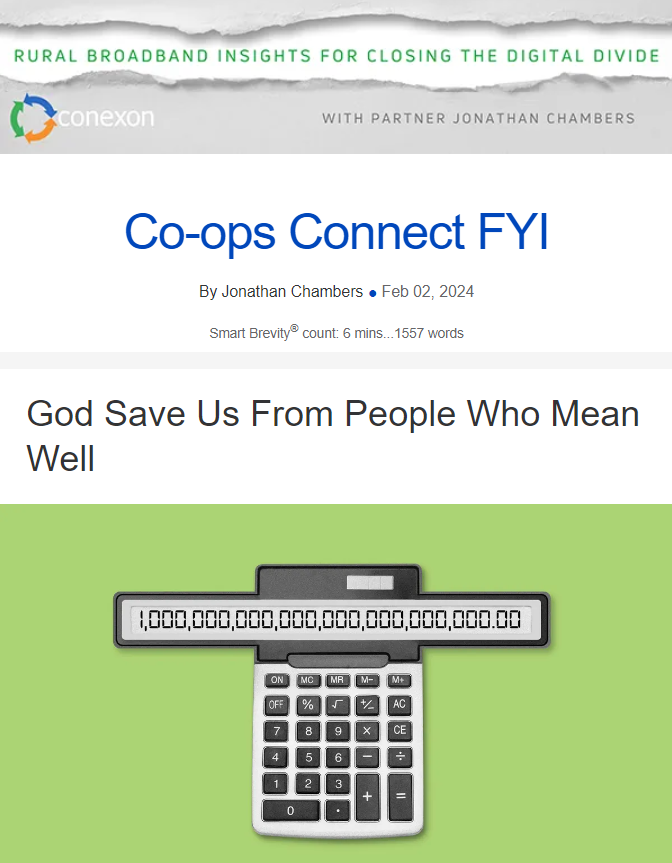God Save Us From People Who Mean Well
February 2, 2024
NTIA’s approach to BEAD – instead of “connect[ing] every resident to reliable, affordable high-speed internet” – is going to relegate rural America to permanent second-class broadband.
- If one were conspiracy-minded, you might suspect this was intentional sabotage by a Democratic Administration.
- But realistically, it is much more likely to be the result of well-meaning, poorly informed policymaking.
Problem:
To make broadband “affordable,” NTIA is forcing BEAD recipients to offer a minimum 100/20 Mbps service tier for $30/month to all low-income households for 10 years.
- Low-income is defined in BEAD — like in the Affordable Connectivity Program (ACP) — as households earning 200% of or below the poverty level.
- For a family of four, that’s a household income of ~$60,000 — or, most households in BEAD-eligible areas.
- That’s $30 per month before any low-income subsidies offered by the FCC and state programs.
Why it matters:
If ACP’s $30 and $75 per household subsidies hadn’t all been spent, NTIA would be effectively requiring free service in all BEAD-eligible areas. And today, NTIA is pushing states to get BEAD applicants to offer a $30 rate in non-BEAD areas, too.
NTIA’s well-meaning approach directly contradicts a different broadband provision in the Infrastructure Act that created BEAD.
- Congress explicitly concluded that, in high-cost areas, $30 per month was an insufficient amount of revenue to support connectivity in rural high-cost areas.
- Congress recognized that monthly revenue of at least $75 per customer was necessary.
ACP and BEAD were meant to work together.
- The broadband subsidies in high-cost areas require a calculation of operating expense and subscriber revenue.
- Under the ACP program, service to areas where the subscriber revenue alone does not cover depreciation expense, operating expense, the cost of capital, and other associated expenses is deemed to cause special economic hardship to any provider, making it uneconomical to maintain the portion of its network.
- Congress concluded that in high-cost areas, $30 in subscriber revenue and subsidies was not enough to make a provider whole.
- For that very reason, Congress provided an enhanced subsidy of $75 for areas where $30 monthly subscriber revenue was insufficient.
- The ACP was to fund that $75 enhanced subsidy (as a passthrough to the consumer) to the provider — the ACP, which has now run dry.
The bottom line:
The gap between $30 and $75 in revenue per customer means that BEAD recipients will be hard-pressed to build fiber networks in BEAD-eligible areas.
The NTIA requirement that BEAD recipients must offer a $30 price plan, when ACP no longer exists, fundamentally undermines the entire $42.5 billion program.
As Senator Dale Bumpers used to say: They’re trying to win too much.
And in the process, rural America will lose because it will not be economical to build fiber networks when a company cannot recover its investment.
The History of ‘High-Cost’ Areas
For decades, Congress and the FCC used the term “high-cost areas” for those areas of the country where it is not economical to build telecommunications networks. These are largely the same geographic areas that gave rise to electric co-ops more than 85 years ago.
Over the past 10 years, the FCC has used various cost models (e.g., Connect America Cost Model, Alternative Connect America Model) to determine the appropriate level of operating subsidy needed to support broadband in high-cost areas.
- The FCC adopted a detailed set of assumptions to model the construction, operation, and maintenance of GPON fiber-to-the-home networks for every census block in the country.
Big picture:
Cost, of course, is only half the equation — revenue is the other.
The FCC has used varying revenue assumptions for telecommunications and internet access service.
- When I was at the FCC, the Commission used a revenue assumption of $75 for the Connect America Fund, coincidentally the same amount as the Infrastructure Act’s high-cost revenue requirement.
- In this manner, the FCC and Congress were attempting to identify those areas where the projected revenue would not cover the costs associated with broadband networks.
Bottom line:
The FCC’s Connect America Cost Models calculated a density threshold of approximately 15 homes per mile. Below that, subsidies are necessary to make fiber construction possible.
That is, “high-cost” defines areas where the population density has not previously supported cable or fiber broadband.
- In such areas, revenue of at least $75 per subscriber is insufficient to cover the cost of construction, operation, and maintenance of a broadband network.
‘High Cost’ By the Numbers
The FCC’s approach to defining high-cost areas has been more fulsome than that articulated in the Infrastructure Act. The Act’s definition equates “high-cost” with over half the rural geography in the country, i.e., any unserved area where the cost is higher than average.
Importantly, both Congress and the FCC reached the same basic conclusions.
- High-cost areas are those where the population density does not support the type of networks available in urban and suburban areas.
- That’s why $75 per month per subscriber is needed in those areas.
Why it matters:
BEAD funding will be directed to high-cost areas.
I expect:
- Nearly all BEAD funding will be spent in areas where the population density is less than 10 homes per mile.
- Most of that will be where the density is less than 6 homes per mile. (The median density of an electric co-op is ~6 members per mile.)
The Simple Math
As an indicator of the BEAD-eligible population density, I looked at American Rescue Plan Act awards for broadband in states where Conexon and our clients have won hundreds of millions of dollars for fiber construction.
- The eligible areas are getting more and more sparsely populated.
- In Conexon’s last half dozen awards, the population densities were 1.4 to 5.4 homes per mile.
Conexon prides itself on efficient fiber construction. We manage the construction of approximately 1,000 miles per week, which includes make-ready engineering and construction, mainline fiber, splicing, and service drops.
Break it down:
- Let’s say you were building one mile to cover 6 homes. In that area, the construction will nearly always be aerial.
- A typical cost per mile of aerial construction for labor and materials, including make-ready construction, mainline fiber, drops and installations, is $35,000 per mile.
- Let’s say a company was able to finance the construction with a 30-year loan at 8% interest.
- The debt service alone for that one mile of fiber will be $257 per month.
- At a minimum, the debt service must be covered by subscriber revenue.
- You can’t expect all six homes will sign up for service. The FCC models 70% subscription rates for high-cost programs; Conexon never assumes more than 60%. So, let’s assume 4 customers for that mile.
- At $30 per month, you wouldn’t cover your debt service — much less pay operational costs (such as back office, DIA, maintenance and repair).
In short, you’ll lose money. Forever.
I understand the NTIA $30 service requirement will only apply to half or three-quarters of BEAD-eligible locations.
- So, maybe two of your customers pay $30 and two pay $50.
- Still short.
I understand a BEAD area means you most likely received a grant. Government grants come with additional government-imposed cost.
- The additional BEAD-imposed costs (including regulatory, environment, labor and materials) means that the typical $35,000 fiber mile will cost more like $45,000.
- Let’s assume the grant is $20,000. You’d still need $183 per month to cover your debt, plus operational expenses.
- Again, still short.
Bottom line:
- Most companies, and even not-for-profit co-ops, don’t invest in projects that will lose money forever.
- And most investors want some return on their investment.
Less-Simple Math to Reinforce
Go deeper:
Conexon has modeled the cost to build fiber networks to every rural home in the country. I’m telling you the NTIA’s requirement for a $30 service won’t work.
Especially since ACP, and the $75 subsidy for high-cost areas, is going away.
Why it matters:
It is pernicious of NTIA to require that BEAD recipients offer a $30 low-income subscriber service in the very areas that Congress and the FCC determined require $75 or more to be economically viable.
Bottom line:
NTIA instead should define affordability to be $30 after applicable low-income subsidies for those households eligible for low-income programs.
That way, a household that qualified for the Lifeline program (the only remaining low-income subsidy) could receive broadband for $30 a month.
An Easy Solution to a Clear Problem
There is a solution using language directly from the Infrastructure Act.
Relief could be given:
“[U]pon a showing that the applicability of the lower limit…[the $30 rate] to the provision of the affordable connectivity benefit by the provider would cause particularized economic hardship to the provider such that the provider may not be able to maintain the operation of part or all of its broadband network…”
— Infrastructure Act, Division F, Title V, § 60502(a)(2)(G)(i)
In other words:
In a BEAD grant area, if an applicant could show that a $30 rate, absent a low-income subsidy, would cause particularized economic hardship, the requirement of a $30 service tier would be waived.
The final word:
Without a change to NTIA’s $30 service tier requirement, rural America will not get the critical infrastructure it needs — even with $42.5 billion in grants.

